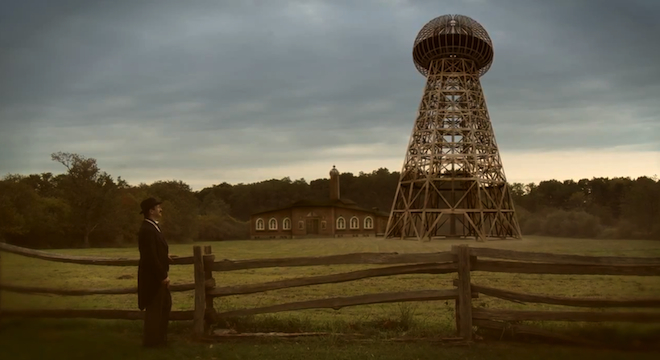Few forces are as fundamental to our daily lives as electricity. It’s partly how this article was written, after all.
Yet one of the pioneers in bringing electricity to the U.S. and the world, Serbian-American inventor Nikola Tesla, proponent of the alternating current (AC), which went on to power over 80 percent of electrical devices in the U.S., hasn’t gotten his proper due from history.
Tesla died in debt, after all, and Thomas Edison, Tesla’s chief rival, went on to become a household name, despite the fact that Edison’s preferred method of electricity transmission, the direct current, never caught on.
That’s at least the thinking of over 30,000 Web users, all of whom have pitched in a collective total $1.2 million to a crowdfunding campaign on the website IndieGoGo (an alternative to Kickstarter), to fund the purchase of Tesla’s last standing laboratory property in the U.S., Wardenclyffe, located in Shoreham, New York, and turn it into a public museum.
The campaign still has two weeks left to collect donations, and the organization behind it is actively rallying followers on Facebook and Twitter for every last dollar.
“I think [Tesla] would have been amused that the internet, which has direct connections to the work he did, has come through with the way to find a solution to funding what may be the most visible form of his legacy,” said Jane Alcorn, president of the Tesla Science Center at Wardenclyffe, a nonprofit that’s in charge of the project in an email to TPM.
The organization linked to the following video ad promoting Tesla’s importance and that of their project and a related effort, a movie called “Fragments From Olympus” that would dramatize Tesla’s life.
How the crowdfunding campaign came about is a story of Internet serendipity gone right. Ever since Tesla’s old, largely abandoned laboratory property was put up for sale for $1.6 million in 2009, the Tesla Science Center at Wardneclyffe, formerly known as Friends of Science East, has sought to acquire it, but lacked the necessary funds.
Then along came Matthew Inman, creator and artist behind The Oatmeal, a popular web cartoon website. A self-avowed Tesla fan, he learned from Twitter messages that the site was up for sale and could be potentially purchased by either the nonprofit or another prospective buyer looking to demolish the foundations and redevelop it into a retail space.
“Matthew Inman discussed with us his willingness to help through crowdfunding for this cause, and he assisted in setting up the fundraising effort,” Alcorn explained to TPM. “He has provided some of the perks for the campaign, and has been a great promoter and supporter.”
Inman has previously conducted several successful crowdfunding efforts through IndieGoGo, including one, “Bear Love Good/Cancer Bad,” out of a legal dispute with another website, FunnyJunk.com, that raised over $200,000 for the National Wildlife Federation and the American Cancer Society.
But the crowdfunding effort for the Tesla museum has been his most wildly successful by far, reaching its goal of $850,000 in less than a week after it launched in late August 2012, going on to raise $1 million in the first nine days, with donations coming in at a rate of $27,000 per hour, according to Inman on his blog.
That goal wasn’t arbitrary either: The state of New York agreed to put up $850,000 in matching funds if that amount of money was raised by the Tesla Science Center.
“The Capital Grant for reimbursement was established for us in 2009 through the office of our then-Assemblyman Marc Alessi,” Alcorn explained. “The NYS reimbursement grant is for up to $850,000. NYS will not be matching $1.2 million.”
Backers of this crowdfunding project, like many others, will get mailed physical “rewards” for their donations, which vary according to amount pledged — everything from bumper stickers to Tesla photos to “limited edition autographed Wardenclyffe poster[s] signed by Tesla’s last remaining relative, William Terbo.”
Inman told CNN that modern industrialist Elon Musk, founder of the Tesla Motors electric car company (and commercial spacefaring company SpaceX, and SolarCity, and formerly PayPal) made a “modest” donation as well.
Tesla had intended to use the Wardenclyffe site to demonstrate wireless power transmission through a giant, 187-foot-tall tower designed, along with the rest of the facility, by architect Stanford White, but the tower was demolished in 1917 by the U.S. government, who feared it could be used by German spies during World War I.
Tesla, due to outstanding debt, was forced to turn the tower over to George Boldt, proprietor of the famed Waldorf Astoria hotel in New York City, who in turn sold it to string of owners, most recently AGFA, a Belgian digital imaging company, which put the property up for sale in 2009 for the $1.6 million, which includes delivering the property to the next buyer clean and free of the toxic chemicals that were dumped there when it was used as a photography processing plant.
But whether the Tesla Science Center is the group that eventually makes the winning bid for their icon’s old property remains to be seen: Another prospective buyer, Serbian-born Russian business owner Milka Kresoja is also reported to be interested in acquiring it, according to The New York Times.
To make matters worse, impostors are seeking to raise money of their own by pretending to be affiliated with the Tesla Science Center, as the organization recently warned on its Facebook page.
Still, Alcorn is optimistic.
“We hope the property will be acquired within the next few months, and then we will begin the restoration part of the process,” Alcorn told TPM. “To open the museum will take millions of dollars more and a lot of work and planning. We have been offered many kinds of services from contributors, and we will be deciding on who will be providing things like architectural, engineering, exhibit, and other services as the process continues.”






